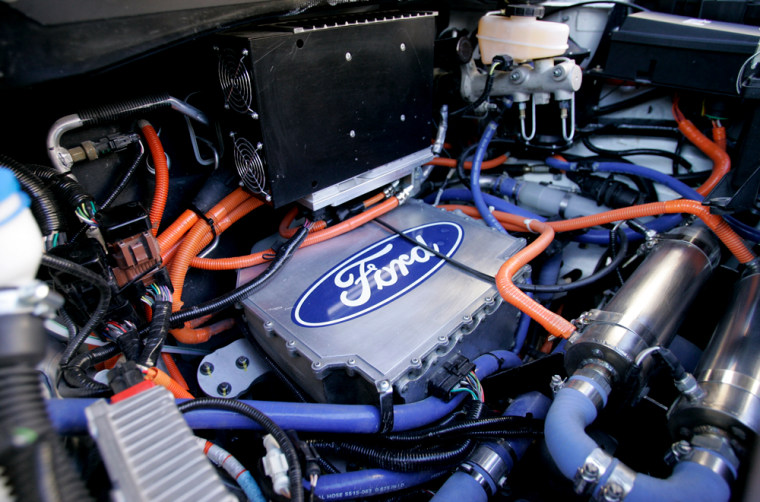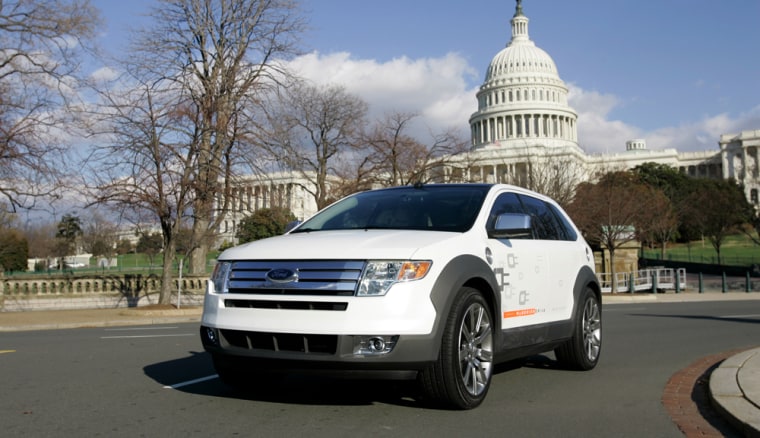Ford Motor Co. on Tuesday showed off its own version of a plug-in hybrid — with a twist. It combines the convenience of plugging in your car with a hydrogen fuel cell.
Called the Flexible Series Hybrid Edge, the concept car represents the latest offering from automakers hoping to stake a claim to the next generation of highly efficient, alternative automobiles.
Gerhard Schmidt, Ford’s vice president of research and advanced engineering, said the vehicle, based on the Ford Edge crossover platform, gives the company “the ultimate in flexibility in researching advanced propulsion technology.”
“We could take the fuel cell power system out and replace it with a downsized diesel, gasoline engine or any other powertrain connected to a small electric generator to make electricity like the fuel cell does now,” Schmidt said.
Ford was showing the plug-in fuel cell at the Washington Auto Show, where lawmakers and government officials were viewing a number of advanced vehicle technologies. The show opens for media previews on the eve of President Bush’s State of the Union address, which is expected to include energy proposals of concern to the auto industry.
Competitors at work, too
Several automakers have been working on similar technologies. General Motors Corp. will display the Chevrolet Volt, a plug-in electric car recently unfurled in Detroit with a range of 40 miles on the battery and more than 600 miles with a gas engine.
DaimlerChrysler AG has been pursuing plug-in hybrids and said Friday it would expand its test fleet in the U.S. to more than 20 Dodge Sprinter vans.
Volkswagen AG will be showing the Golf GT TSI for the first time in the United States. The vehicle’s supercharged gasoline engine has 170 horsepower while garnering 40 miles per gallon in the city and 48 mpg on the highway. VW estimates the vehicle gets 638 miles on one tank of fuel.
Edge stats
Ford’s plug-in hybrid Edge operates in ‘battery only’ mode for the first 25 miles, moving at speeds of up to 85 miles per hour. When the battery is depleted to 40 percent, it seamlessly shifts to the fuel cell mode, which recharges the battery for 200 more miles of range.

The 336-volt lithium ion battery pack can be fully charged overnight — in about eight hours — with either a 110 or 220 volt outlet and the engine produces gas mileage of about 41 miles per gallon. Drivers who travel less than 50 miles per day would get more than 80 miles per gallon, Ford said.
The combined plug-in-hydrogen vehicle offers a new way to address some of the challenges of hydrogen fuel cells. The technology could provide a sustainable energy source through the mixture of hydrogen and oxygen, but it faces a number of hurdles with its size, weight, cost and lack of a fueling infrastructure.
Hydrogen has to be obtained from some other source, like water or a fossil fuel. The former would provide emission free energy if wind or solar power were to be used to split water, but the costs are still high. The later is less expensive but emits some pollution in the process of getting hydrogen from a fuel like natural gas.
Ford reduced the fuel cell’s size, weight and cost in half and said their approach would double the lifespan of the fuel cell’s stack. Mujeeb Ijaz, Ford’s manager for fuel cell vehicle engineering, said the changes were “a great step to commercializing” the vehicle.
Ford has not committed to a date when the vehicle would be available. The automaker said the vehicles cost millions of dollars each and commercialization remains hindered by a lack of a hydrogen infrastructure and the cost of lithium-ion batteries.
